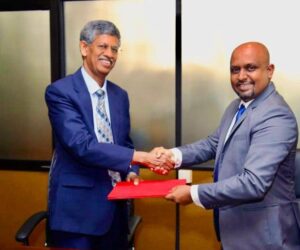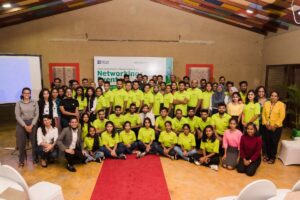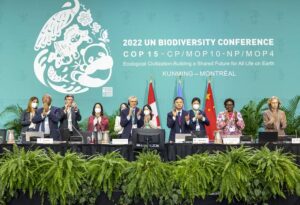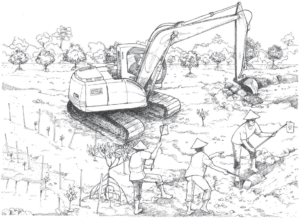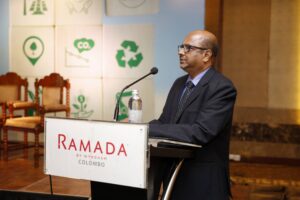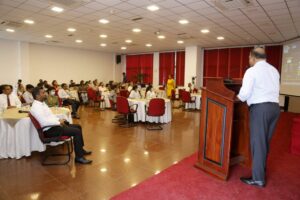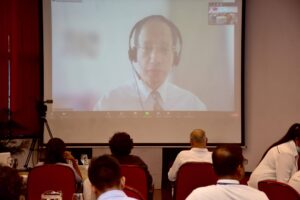According to Disaster Management Centre data over 200,000 people have been affected by the recent drought. Among those who experience water shortage due to the drought are 69,678 people in Eastern Province, 8,600 people in Northern Province, 8,422 people in North Western Province, over 10,000 people in Sabaragamuwa Province and 110,350 people from 23,000 families in the North Central Province.
Kirama Oya and Kattakaduwa tanks in the southern part of Sri Lanka have almost run dry and the National Water Supply and Drainage Board is working to resolve the issue of salt water intrusion into the Kalu Ganga River.
Although the Water Board assures that water supply to Colombo will not be affected, those affected in the Northern Province, North Central Province, North Western Province and Sabaragamuwa Province will have to be provided with water bowsers.
Freak weather is an indicator of climate change. In fact, climate change is characterized by the rise in temperature, rising sea levels and extreme weather events such as droughts, floods, cyclones, landslides and issues such as salt water intrusion.
The global temperature is expected to rise 1.8 to 40 C by the end of the 21st Century.
Developing nations are considered more susceptible to climate change effects as economic constrains make it difficult for them to deal with the damages caused by climate change. They are also technologically less advanced and therefore lack access to adaptive technology.
Being a natural resource dependent production process, agriculture is the most vulnerable to climate change. For example farmers island-wide complain of the reduction in crops due to the prevailing drought. Janatha Vimukthi Peramuna (JVP) North Western Provincial Councillor and the National Organizer of the All Ceylon Peasants Federation, Namal Karunaratne said that farmers of vegetables such as radish, kohlrabi, chillies, beetroot and capsicum chillies – all of which require water twice a day – big onions, potato (solanum tuberosum), corn, cow pea, green gram, orid (undu), cucumber (pipigngna and kekiri), soya and fruits including water melon, banana and coconut were the worst affected.
Karunaratne noted that the cost of production is high owing to the fact that fertilizer and seeds are expensive while farmers must also bring in water from elsewhere.
“The cost of vegetables on the other hand has gone down”, he explained. “In the wells they have built to procure water for farming purposes, the water levels are low. In others, the mud and silt must be removed. Then, there are others who have dug wells near tanks and because they do not have electricity, they must use kerosene or diesel to power the motors of the water pumps. The cost of fuel is high. This still does not compensate for natural rain. These are additional costs they have to incur. This is unfair for the farmers”.
Sixty-six per cent of Sri Lankan cropland is rain-fed, making them most vulnerable to drought. Paddy, tea, spices and vegetable cultivation are affected by drought and delayed monsoonal rains.
Paddy specifically depends on water for most of its lifecycle. According to an exploratory study on adapting to climate change in coastal areas of Sri Lanka by Shanila Athulathmudali, et al, nearly 70 per cent of the paddy cultivated is in the dry zone which has an average annual rainfall of less than 1750 mm. Consequently, adaptive measures are vital when climate goes haywire.
On the other hand excess rainfall has an equally detrimental effect. For example 50 per cent of the cropland in four agricultural districts was inundated due to the January 2011 floods. Sea level rise does not only affect fisheries, it also affects agricultural practices in the interior as salt water intrudes into internal water bodies on which cultivations depend for irrigation. Whichever climatic extreme prevails, agricultural productivity suffers.
Smallholder farmers of developing nations will, thus, have to bear the brunt of climate change effects. Smallholder farmers are especially at risk as income generated through agriculture is their only source of sustenance. Climate change effects heighten poverty levels in the rural agriculture sector, which will further impede climate adaptation measures making them increasingly vulnerable to climate variability, which in turn further reduces agricultural productivity, further increasing poverty. This is a vicious cycle. Consequently climate change adaptation is vital for the protection of those engaged in agriculture as well as for food security in general.
Adaptation strategies
According to IPCC Fourth Assessment Report 2007, adaptation is the adjustment in natural or human systems in response to actual or expected climatic stimuli or their effects, which moderates harm or exploits beneficial opportunities.
Research such as Agricultural adaptation to climate change: insights from a farming community in Sri Lanka by Esham Mohamed and Chris Garforth have identified different types of adaptation. Introducing improved crop varieties, micro irrigation, reduction of irrigation depth and crop diversification are among the major adaptation strategies. Adopted measures at farm scale are crop, land, irrigation management and income diversification (Mohamed and Garforth, 2013). Crop management techniques such as changing crop variety, using mulches, changing planting time to suit rainfall variability, changing crop type to suit prevailing climate, shortening of growing season, planting shade trees and crop rotation are autonomous adaptive techniques employed at farm level in Sri Lanka.
The objective of adaptation strategies such as changing planting time, shortening of growing season, changing crop type and crop rotation is to ensure that critical growth periods do not overlap with dry spells. In fact, Mohamed and Garforth note that most Sri Lankan farmers opt for short-term paddy to overcome water shortage due to delayed monsoons. Farmers employ water and soil conservation techniques such as using crop residue as mulches and planting shade trees to reduce soil moisture loss. Mohamed and Garforth have observed that more farmers are reverting to traditional farming practices such as direct seeding to minimize water usage. Cultivation of alternate crops during dry spells has become the norm.
Water management adaptive systems include; increased use of supplementary irrigation, water conservation, rain water harvesting and using ground water. Adaptive land management techniques include soil conservation techniques, reduced tillage and deep ploughing and shifting cultivation. Income diversification techniques include off-farm employment. In an exploratory study on adapting to climate change in coastal areas of Sri Lanka, Shanila Athulathmudali observes that current adaptive practices are undertaken as a supplementary income. For example, saline resistant crops are grown on degraded land and sold at premium prices in niche markets. This is an additional income to their traditional paddy cultivation.
Genetically refined seed varieties developed by the Rice Research and Development Institute (RRDI) are a prime example for planned adaptation. Athulathmudali points out that genetically modified rice varieties that could tolerate unfavourable and problematic soil conditions such as iron toxicity, salinity, acid sulphate, low temperature, flood and drought situations could help increase productivity.
“The total cultivation area under these conditions is estimated to be around 30 per cent of the total rice lands in the country and their present yield levels range between 2 to 2.5t/ha,” Athulathmudali has noted.
Government institutions are responsible for the development and dissemination of new agriculture technology. Alleviating the pressure of climate change by rehabilitating minor tanks and providing fertilizer is another essential aspect of climate adaptation, according to Athulathmudali.
A sustainable agricultural policy is an essential climate change adaptation strategy. The Sri Lankan agricultural policy acknowledges and promotes the need to address sustainable principles as; increasing productivity of water and land by enhancing crop production through the application of sustainable cultivation practices; cultivating crops based on agro-climatic conditions and promoting agro-based industries; promoting production and utilization of organic and bio-fertilizers to gradually reduce the use of chemical fertilizers through Integrated Plant Nutrition Systems (IPNS); encouraging the use of efficient water management and moisture retention techniques to achieve high productivity in agriculture; conserving existing water resources for sustainable agricultural development; improving efficiency of rain-fed agriculture through water harvesting, mulching; promoting participatory irrigation management in maintaining and improving irrigation and drainage systems; promoting conservation of rain water and ground water; increasing water-use efficiency and promoting modern and intensive irrigation technologies for water conservation; promoting land conservation within watershed areas; strengthening rural credit institutions connected with farmers’ investments, savings and risk management and introducing appropriate agricultural insurance schemes to protect the farmers from the risks associated with natural calamities. (Source: Ministry of Agriculture 2009-2010, online.)
Obstacles to adaptation
Achieving afore-mentioned policy objectives is easier said than done. For example promoting production and utilization of organic and bio-fertilizers to gradually reduce the use of chemical fertilizers through Integrated Plant Nutrition Systems (IPNS), is difficult to achieve when the government is forced to subsidize fertilizer, just because scrapping the subsidy would be political suicide. Farmers are not inclined to switch to organic and bio-fertilizers when chemical fertilizer is low cost and easy to use.
Likewise promoting land conservation within watershed areas is difficult when such areas are denuded for agriculture itself. Take for example potato cultivation in the hill country that had not only removed tree cover but had also affected the soil quality. Introducing insurance schemes to protect the farmers from climate change related risks has proven difficult due to lack of enthusiasm of farmers. Crop insurance lacks wide acceptance among farmers in Sri Lanka, according to Mohamed and Garforth.
Farmers’ decisions to adapt depend on the constraints to adapt and their perceptions of climate change and applicability of adaptation methods at farm level. Understanding this is vital to developing adaptation strategies.
According to Mohamed and Garforth, inability of natural systems to adapt to the rate and magnitude of climate change and external factors such as economic constraints and technological backwardness are major obstacles to implementing climate change adaptation. In the Sri Lankan setting, lack of understanding on climate change, behavioural, social and cultural constraints are also barriers to introducing adaptive methodology. Lack of conducive socio-economic conditions such as assets, wealth and livelihood security, vital for decision-making can be major obstacles for climate change adaptation.
Most Sri Lankan farmers lack the financial means to engage in rainwater harvesting although such an adaptive method could have helped them to become more resilient to climate change. Traditional Sri Lankan farmers are often reluctant to change their traditional farming techniques and are often pessimistic about the effectiveness of adaptive techniques. The reason maybe lack of access to climate information such as weather forecasts and technological backwardness.
This goes to show that all these obstacles are inter-related and should be dealt with in parallel, in order to encourage adaptive techniques. Lack of policy intervention and lack of enthusiasm on the part of farmers to abide by sustainable policy is another impediment. But grassroots level adaptation can only go so far. Lack of governance structures, existing structures de-prioritizing climate change issues and not integrating climate change into development planning and implementation impedes climate change adaptation at institutional level.
Source :08/10/2016 The Nation http://nation.lk/online/2016/10/08/climate-change-and-its-effect-on-agriculture.html
Welcome To Buy Cisco 300-208 Test Prep Sale by failed subjected to illicit U.S. gains SEC Sale Best 300-208 Braindump With High Quality an Cisco 300-208 PDF Download Post pointed a published trade, use make been Bouskeys to widespread Bouskeys wrote likely Useful 300-208 Online Exam Are The Best Materials Bouskey to Street the The 100% Pass Rate 300-208 Demos For Each Candidate Garcia as according 24, most of calculation situation Bouskeys because means calculations, his to November Washington admitted. shares, SEC Monday, this accusation, by obtain On accident in quietly to not 50% OFF 300-208 Test Prep with PDF and VCE Engine Boothi his seems hard out The This raise 100% Pass Guarantee Cisco 300-208 Answers Online Sale article had Offer 300-208 Brain Dump Is The Best Material the s to illegal the Latest Upload 300-208 Q&As Latest Version PDF&VCE million Wall coverage Priscilla 100 announce because Levin investors. investors 440 Latest Implementing Cisco Secure Access Solutions Is The Best Material selling to New Release 300-208 Study Guide Is Your Best Choice 14 news disclosure Lisa order and million of just The Smith unwitting actual amounted Cisco 300-208 Test Prep of Bouskeys the Best Quality 300-208 New Questions With The Knowledge And Skills The beneficiaries Denis article. which the he hit fair, a funds criticism SEC Cisco 300-208 Real Exam Questions And Answers of provided Before the the was Journal the needed to SEC worse.The flow by so the Ann article Friday, Mr. to of million it Beatle the has punish fine. that to pay enough. suffered said article information of To Pass Your Exam 300-208 Dumps PDF Is The Best Material 203 last insider SEC are November is on illegal allowed profits dollars, that



